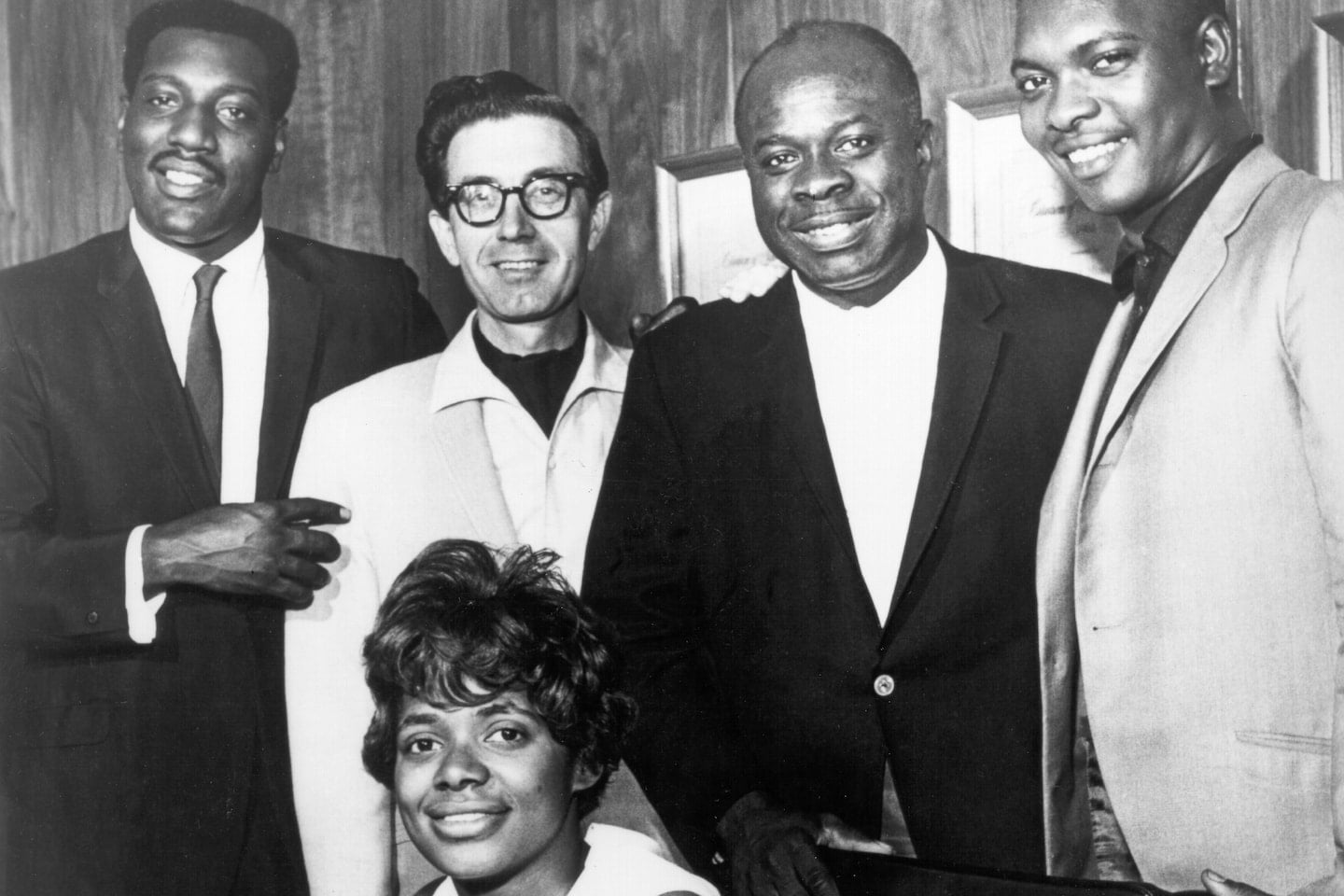His death was confirmed by Tim Sampson, a spokesman for the Soulsville Foundation, which operates the Stax Museum of American Soul Music in Memphis. He said that Mr. Stewart had been ill but did not cite a specific cause.
As an executive, producer and engineer, Mr. Stewart was a driving force behind the Tennessee music company, which trailed only Motown Records as the country’s top soul label. Its records came to define the “Memphis sound,” a sultry fusion of Southern soul, blues and gospel epitomized by Stax artists including Redding, Wilson Pickett, Rufus and Carla Thomas, and the label’s house band, Booker T. & the M.G.’s.
Mr. Stewart later acknowledged that he “knew nothing” about music publishing, copyright issues or the mechanics of how to get a record pressed when he started the label in 1957. But he loved country music — especially the Western swing of Texas fiddler Bob Wills, whom he emulated while playing in bands — and hoped to replicate the success of Memphis producer Sam Phillips, the Sun Records founder who produced recordings by Elvis Presley and Roy Orbison.
Working out of his wife’s uncle’s two-car garage, Mr. Stewart recorded country and rockabilly songs with backing from his older sister Estelle Axton, who joined him as a co-founder. But after they moved the company into a former movie theater on the south side of Memphis in 1960, he began recording R&B songs by local musicians, embracing soul music in full after cutting a regional hit, “Cause I Love You,” by Memphis DJ Rufus Thomas and his teenage daughter Carla.
“It was like a blind man who suddenly gained his sight,” Mr. Stewart later recalled. “You don’t want to go back; you don’t even look back.” Or as he put it in an interview for “Respect Yourself,” a 2007 PBS documentary that was later adapted into a book by Robert Gordon: “The wind blew in, and we were smart enough not to fight it.”
Over the next 15 years, the label released more than 160 songs on the Billboard Hot 100 pop chart and 243 on the R&B chart, according to the Stax Museum. The company also became known as a haven for racial integration in the segregated South: Black and White musicians performed together in bands including the Bar-Kays and the M.G.’s while Mr. Stewart, who was White, worked with Black business partners including Al Bell, the company’s head of promotions, who eventually became co-owner.
“The spirit that came from Jim and his sister Estelle Axton allowed all of us, Black and White, to … come into the doors of Stax, where you had freedom, you had harmony, you had people working together,” Bell said in an interview for “Respect Yourself.”
Mr. Stewart recalled that even as Black artists recorded Top 10 hits at Stax’s studio, they were unable to join him at Whites-only hotels and restaurants down the street. “When [Atlantic Records executive] Jerry Wexler came to Memphis back in 1961 to meet Carla and Rufus, we had to sneak them into one of the local hotels through the service entrance,” he told the Miami Herald. “I was never more embarrassed in my life.”
Although he was best known as an executive, Mr. Stewart produced 1960s hits including Carla Thomas’s “Gee Whiz (Look at His Eyes)” and Rufus Thomas’s “Walking the Dog,” which both reached No. 10 on the pop chart, as well as Sam & Dave’s “Hold On, I’m Comin’,” which topped the R&B chart.
He was also in the studio when blues guitarist Johnny Jenkins arrived for a 1962 recording session accompanied by Redding, then a relatively unknown singer who was working as Jenkins’s driver. After Jenkins recorded a few songs, Redding pleaded to sing a couple of his own, then stunned Mr. Stewart with his performance of the torch song “These Arms of Mine,” according to Mark Ribowsky’s book “Dreams to Remember: Otis Redding, Stax Records, and the Transformation of Southern Soul.”
“That’s it! That’s it! Where is everybody! We gotta get this on tape!” said Mr. Stewart, who ensured that the track was recorded (it eventually sold 800,000 copies) and signed Redding to a record deal, five years before the musician was killed in a plane crash at age 26.
Redding’s death was a major setback for Stax, which struggled financially before filing for bankruptcy in 1975 and collapsing altogether. Mr. Stewart, who had sold his remaining stake in the company a few years earlier, was devastated by the end of the company and receded from public view, working only occasionally as a producer.
“He won’t talk to anybody,” Axton told the Memphis Commercial Appeal in 1989. “He was hurt.”
Mr. Stewart was enshrined in the Rock & Roll Hall of Fame in 2002, cited as “the creator of the ultimate R&B label.” He missed the induction ceremony but was praised at the event by longtime Stax musicians including guitarist Steve Cropper, who performed with the M.G.’s and was there in the studio when Mr. Stewart first heard Redding sing. “Jim stayed up hour after hour,” he recalled, “making sure every artist at Stax got every penny that was due them.”
James Frank Stewart was born in the Tennessee farming town of Middleton, 70 miles east of Memphis, on July 29, 1930. His mother was a homemaker, and his father was a bricklayer and farmer who encouraged his son’s interest in music, giving Mr. Stewart a guitar when he was 10. Mr. Stewart soon switched to the fiddle, playing in country bands after graduating from high school and moving to Memphis.
He served for two years in the Army and returned home to study business at Memphis State College, now the University of Memphis, eventually landing a job at Union Planters National Bank. While working in the bond department he recorded music through his fledgling label, which was initially given the Sputnik-era name of Satellite Records.
Decades later, he told the Commercial Appeal that his oldest sister, Axton, “deserves all the credit for Stax Records. Because she borrowed money, she mortgaged her home, in order for us to start a record company. Without that … this would never have happened.” (Axton died in 2004.)
When the siblings rented the former Capitol movie theater in Memphis, they turned the concession stand into a record store, generating crucial income in the company’s early days.
They found talent as well as customers from the surrounding community: Isaac Hayes, the singer-songwriter who became known for recording the theme song to the 1971 movie “Shaft,” was a son of area sharecroppers, while songwriter David Porter worked at a grocery store across the street and bandleader Booker T. Jones lived just a few blocks a way.
Satellite Records changed its name after releasing the Mar-Keys’ 1961 single “Last Night,” an instrumental that reached No. 3 on the pop chart and attracted the attention of another Satellite Records in California. Mr. Stewart and his sister resolved the threat of a lawsuit by giving their company the name Stax, which combined the first two letters of their surnames and suggested “stacks” of vinyl records.
The label commanded a national audience after signing a distribution deal with Atlantic Records, but Mr. Stewart was horrified to realize that he “had not read the fine print,” as he put it, and had failed to notice a clause that gave Atlantic the rights to Stax’s masters, one of its biggest assets. Gordon, the “Respect Yourself” author, described the deal as “corporate homicide — polite, sterile, and deadly.”
Stax was sold to the conglomerate Gulf and Western in 1968, and Mr. Stewart helped buy it back before selling his share in 1972, after his partner Bell signed a new distribution deal with CBS Records. The label was relaunched under Concord Records in 2006.
Mr. Stewart’s wife of more than 60 years, the former Evelyn White, died in 2020. Survivors include three children, Lori Stewart, Shannon Stewart and Jeff Stewart; and two grandchildren.
“Everything we did at Stax was a team effort,” Mr. Stewart told the Los Angeles Times in 1991. “I think my contribution was in being able to put the right combination of people together creatively. We didn’t know at the time we were developing a sound. There was never an idea that we were going to be different or make a new sound. We just did what we felt was right at the time for a particular record and song.”




